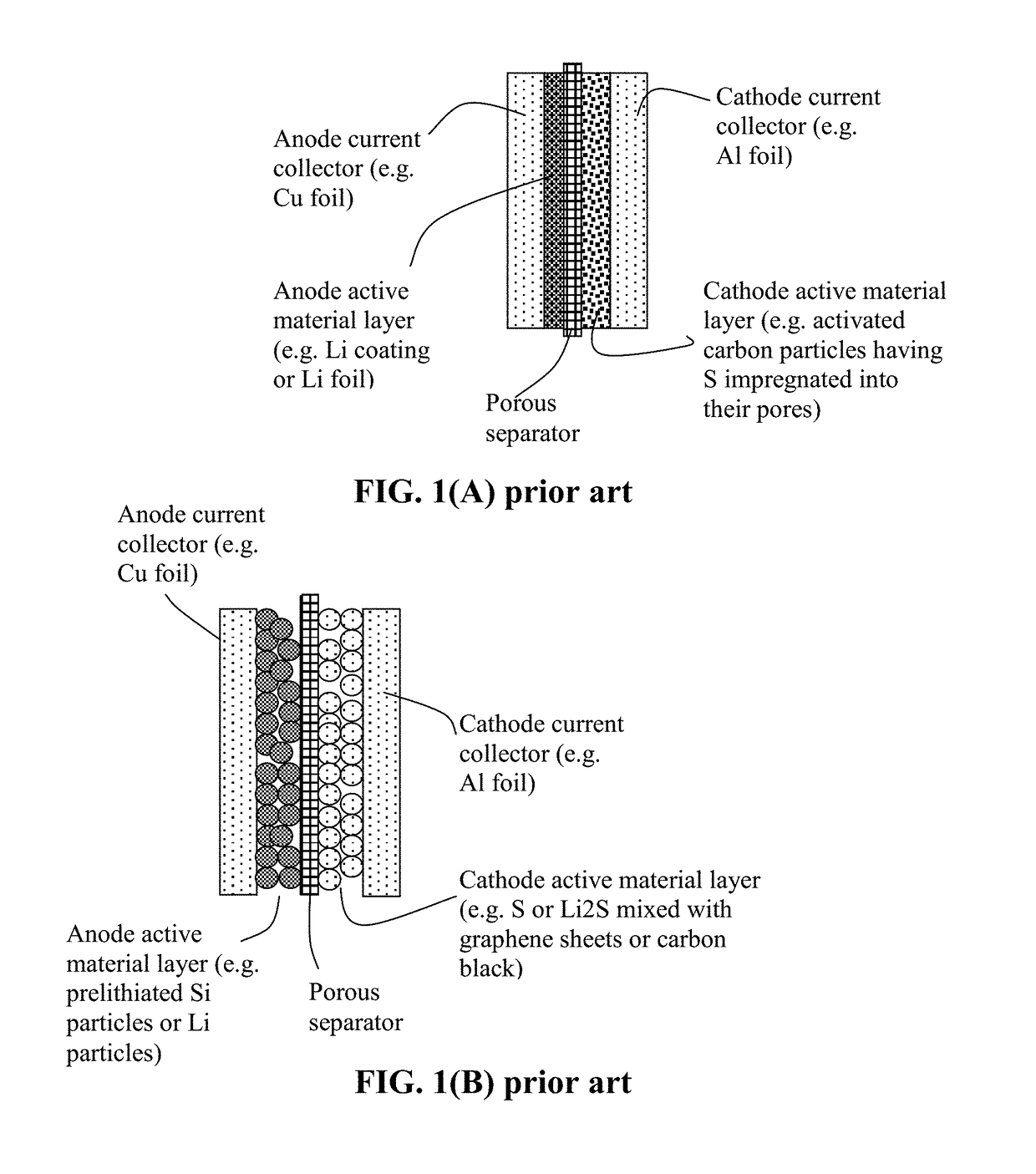Alkali Metal-Sulfur Secondary Battery Containing a Protected Sulfur Cathode and Manufacturing Method
a technology of sulfur cathode and secondary battery, which is applied in the manufacture of final products, cell components, electrochemical generators, etc., can solve the problems of dendrite formation, internal shorting, and state-of-the-art li-ion batteries that have yet to meet cost and performance targets, so as to reduce or eliminate the shuttling effect, block diffusion, and reduce the effect of
- Summary
- Abstract
- Description
- Claims
- Application Information
AI Technical Summary
Benefits of technology
Problems solved by technology
Method used
Image
Examples
example 1
The Ethoxylated Trimethylopropane Triacrylate Monomer-Derived High-Elasticity Polymer
[0158]In a representative procedure, the ethoxylated trimethylopropane triacrylate monomer (ETPTA, Mw=428, Sigma-Aldrich) was dissolved in a solvent mixture of ethylene carbonate (EC) / diethyl carbonate (DEC), at a weight-based composition ratios of the ETPTA / solvent of 3 / 97 (w / w). Subsequently, benzoyl peroxide (BPO, 1.0 wt. % relative to the ETPTA content) was added as a radical initiator to allow for thermal crosslinking reaction after mixing with cathode particles. Then, cathode active material particles (e.g. S-graphene particles) were dispersed in the ETPTA monomer / solvent / initiator solution to form a slurry, which was spray-dried to form ETPTA monomer / initiator-embraced S-graphene particles. These embraced particles were then thermally cured at 60° C. for 30 min to obtain the particulates composed of S-graphene particles encapsulated with a thin layer of a high-elasticity polymer. The ETPTA po...
example 2
Preparation of Cyano-Ethyl Polyvinyl Alcohol-Derived High-Elasticity Polymer
[0162]The high-elasticity polymer for encapsulation of several sulfur- and lithium polysulfide-based cathode particles was based on cationic polymerization and cross-linking of the cyanoethyl polyvinyl alcohol (PVA-CN) in succinonitrile (SN). The procedure began with dissolving PVA-CN in succinonitrile to form a mixture solution. This step was followed by adding an initiator into the solution. For the purpose of incorporating some lithium species into th high elasticity polymer, we chose to use LiPF6 as an initiator. The ratio between LiPF6 and the PVA-CN / SN mixture solution was varied from 1 / 20 to ½ by weight to form a series of precursor solutions. Subsequently, particles of a selected cathode active material and their graphene-embraced versions were introduced into these solutions to form a series of slurries. The slurries were then separately subjected to a micro-encapsulation procedure to produce cathod...
example 3
Preparation of Pentaerythritol Tetraacrylate-Derived High-Elasticity Polymer
[0164]For encapsulation of sulfur-carbon, sulfur-graphite, and sulfur-polymer hybrid particles, pentaerythritol tetraacrylate (PETEA), Formula 3, was used as a monomer:
[0165]The precursor solution was typically composed of 1.5wt. % of PETEA (C17H20O8) monomer and 0.1 wt. % of azodiisobutyronitrile (AIBN, C8H12N4) initiator dissolved in a solvent mixture of 1,2-dioxolane (DOL) / dimethoxymethane(DME)(1:1 by volume). Different sulfur-based hybrid particles were added into the precursor solution and were encapsulated with a thin layer of PETEA / AMN / solvent precursor solution via the spray-drying method (some solvent evaporated, but some remained). The precursor solution was polymerized and cured at 70° C. for half an hour to obtain particulates composed of high-elasticity polymer-encapsulated particles.
[0166]The reacting mass, PETEA / AMN (without cathode particles), was cast onto a glass surface to form several fil...
PUM
 Login to View More
Login to View More Abstract
Description
Claims
Application Information
 Login to View More
Login to View More - R&D
- Intellectual Property
- Life Sciences
- Materials
- Tech Scout
- Unparalleled Data Quality
- Higher Quality Content
- 60% Fewer Hallucinations
Browse by: Latest US Patents, China's latest patents, Technical Efficacy Thesaurus, Application Domain, Technology Topic, Popular Technical Reports.
© 2025 PatSnap. All rights reserved.Legal|Privacy policy|Modern Slavery Act Transparency Statement|Sitemap|About US| Contact US: help@patsnap.com



